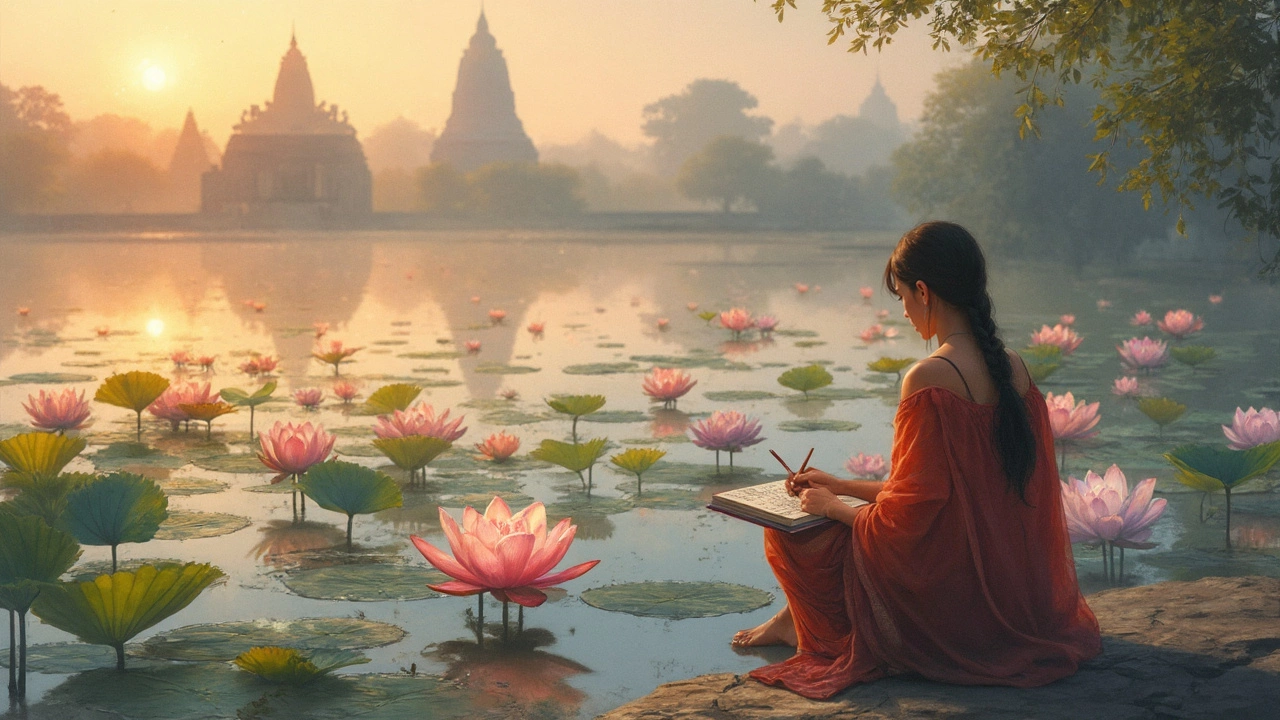The national flower of India? It's the lotus. Not your average water plant—this one shows up everywhere from temples to jewelry stalls. But it's not just about looks. The lotus has deep roots (pun intended) in Indian culture, and it holds a seat at the table when it comes to the country's arts and crafts.
People often spot lotus patterns in Indian textiles, carvings, and pottery. This isn't random. There's always a story behind why the lotus keeps popping up, and it's more than just because it looks good. Even if you’re not familiar with the flower, chances are, you’ve seen it on an Indian saree, a wall hanging, or a Diwali rangoli design.
If you’ve ever wondered how a simple flower can have such a big impact on a country's design sense and craft traditions, you’re in for some surprises. There’s plenty about the lotus that you probably don’t know, especially when it comes to the tricks craftspeople use to make this symbol shine in everyday items.
- Why the Lotus Became India's National Flower
- Lotus in Indian Art and Symbolism
- How Craftspeople Use the Lotus Motif
- Fun Facts About the Lotus in Indian Culture
- Tips to Use Lotus Designs in Your Own Crafts
Why the Lotus Became India's National Flower
So, how did the lotus end up as India's big floral symbol? There are more than 18,000 plant species in India, but the lotus stands out for its history and its meaning. In 1950, after India became a republic, the government officially picked the national flower India as the lotus (Nelumbo nucifera). Why? It wasn’t just a beauty contest. They picked it for what it represents across so many Indian communities—purity, renewal, hope, and unity.
One key reason: the lotus keeps blooming even in muddy water. That whole “rising above the muck” vibe pops up in a bunch of Indian religions and traditions. You see it in stories from Hinduism (it’s linked to Lakshmi and Brahma), Buddhism (Buddha is often shown sitting on a lotus), and even Jainism. It’s a flower that sort of says, ‘Hey, things can try to drag you down, but you can bloom anyway.’ This idea connects well with how India sees itself—resilient through ups and downs.
Here’s another interesting bit. The lotus isn’t some rare, hard-to-find blossom. It grows in lakes, ponds, and even roadside water bodies all over the country. This means it’s something everyone can relate to and spot. So, it’s inclusive, too.
If you’re into numbers or facts, check this out:
| Detail | Info |
|---|---|
| Scientific Name | Nelumbo nucifera |
| Chosen as National Flower | 1950 |
| Where It Grows | Ponds, lakes across India |
| Symbolizes | Purity, resilience, rebirth |
| Used In | Festivals, rituals, handicrafts, art |
This flower is everywhere—in prayers, celebrations, art, and crafts. When the government chose the lotus, they wanted something every Indian could connect with. It didn’t hurt that the lotus looks pretty epic in carvings and paintings, either.
Lotus in Indian Art and Symbolism
You can’t talk about Indian art without running into the national flower India: the lotus. This isn’t just about decoration. In Hinduism, almost every god and goddess you can name sits or stands on a lotus. For example, Lakshmi, the goddess of wealth, is always shown with lotus blooms around her. The same goes for Saraswati, the goddess of learning. Buddhists also see the lotus as a symbol of purity and spiritual growth. Even Jain temples use the lotus motif in their architecture and paintings.
Look at Indian coins, paintings, old temple carvings, or festival rangolis—lotus patterns show up everywhere. Why? In India’s hot, muddy ponds, the lotus grows fresh and clean, totally untouched by the dirt below. People saw this and started linking the flower with ideas like purity, hope, and resilience. This thinking spread to art fast.
- Lotus petals decorate entrances, pillars, and domes in centuries-old temples from Tamil Nadu to Varanasi.
- Mughal emperors used lotus shapes on carpets, palace walls, and even weapons. Artisans still use these designs for woodwork and marble inlay today.
- Miniature paintings from Rajasthan are packed with lotus blooms as a backdrop or as part of royal portraits.
There’s some cool data here too:
| Area | Common Lotus Use |
|---|---|
| Textiles | Handwoven sarees (Varanasi, Bengal) |
| Architecture | Temple pillars, capitals, marble flooring |
| Painting | Miniatures, murals, folk art |
| Jewelry | Ear studs, pendants, bangles |
It’s not just old crafts either. Today’s designers use the lotus for modern home décor, like wall decals, table mats, and cushion covers. So if you notice a lotus popping up on something handmade from India, now you know—it’s about tradition, but it’s also about telling a bigger story of what people value.

How Craftspeople Use the Lotus Motif
The lotus isn’t just a symbol—it's basically everywhere you look in Indian handicrafts. Want proof? Just check out any local market and you'll spot lotus patterns on textiles, woodwork, metal, and even clay pots. Artisans know the lotus is special, and they keep coming up with different ways to work it into their designs.
Let’s break down where you’re most likely to find lotus artwork:
- Textiles: You’ll see the lotus popping up on sarees, bedsheets, cushion covers, and carpets. In places like Varanasi, silk weavers are famous for detailed lotus motifs in Banarasi sarees. The big draw? The pattern is both easy to recognize and instantly connects with anyone who spots it.
- Pottery & Ceramics: Clay lamps (diyas) and vases covered with hand-painted or carved lotus designs sell fast, especially around festivals.
- Jewelry: Silver and goldsmiths create nose-pins, pendants, and bangles carrying the iconic lotus shape. This style isn’t just for show—many believe wearing lotus jewelry brings good luck.
- Furniture: Carved wooden lotus handles, headboards, or panels are a thing, and it’s easy to see why. They make simple pieces look a lot more interesting.
- Rangoli and Folk Art: From weddings to Diwali, people love making lotus rangoli at their doorsteps. It’s almost like a welcome sign, and you’ll find versions of it in Warli, Madhubani, and Pattachitra paintings.
What makes the lotus so popular among craftspeople? Part of it is the meaning—lotus stands for self-growth and rising above challenges, which a lot of folks like to represent in their art. But it’s also practical. The shape is easy to adapt, whether you want something complex or a simple outline.
Here are some ways crafts businesses play with the lotus motif:
- Block printing for repetitive, bold lotus designs on fabrics
- Laser-cut metalwork in jewelry or décor that gets all those little details right
- Hand painting or carving to add customized touches on small runs
And to give you an idea of how common the lotus motif is, check out this quick stat:
| Handicraft Type | % Featuring Lotus Motif (Surveyed Items) |
|---|---|
| Banarasi Textiles | 43% |
| Madhubani Paintings | 67% |
| Traditional Jewelry | 31% |
| Hand-painted Clayware | 49% |
So if you're thinking about adding a slice of Indian culture to your own creative projects, taking inspiration from the national flower India motif is a total no-brainer.
Fun Facts About the Lotus in Indian Culture
If you start digging into why the lotus is everywhere in India, you’ll see it’s more than just a pretty face. The flower shows up in stories, coins, temples, and even tattoos. Here’s some stuff you probably didn’t know—but should—if you want to get the big picture.
- The national flower India status for the lotus was officially declared in 1950, just three years after independence.
- In Hinduism, major gods like Vishnu and Lakshmi sit or stand on lotuses. The flower literally supports divinity, so to speak.
- The lotus goes by many names in India—most commonly “Kamal” in Hindi and “Tamara” in Tamil.
- If you check out old Indian coins, some have lotus designs on them that go back as far as the Maurya Empire (more than 2,000 years ago).
- The idea of something beautiful growing out of mud gives the lotus a special place in Buddhist and Jain teachings as well. It stands for hope, peace, and rising above messy stuff in life.
- Indian schools sometimes use the lotus symbol on uniforms and notebooks because it's supposed to inspire 'purity of thought.'
- In 2023, India was ranked among the top exporters of lotus seeds and roots, which are used in both food and Ayurvedic medicine.
Need numbers to back it up? Check this out:
| Lotus Fact | Details/Stats |
|---|---|
| Year declared as national flower | 1950 |
| Common names in India | Kamal (Hindi), Tamara (Tamil), Thamara (Malayalam) |
| Main states growing lotus | West Bengal, Uttar Pradesh, Tamil Nadu, Kerala |
| Cultural festivals featuring lotus | Pushkar Fair (Rajasthan), Lotus Festival (Delhi) |
| Average number of petals | Usually 15-25 |
You’ll spot the lotus all over Indian artwork, but it’s not just there for style points. Every petal has a backstory, whether it’s about spiritual growth or just representing a country that likes to see beauty in tough places.

Tips to Use Lotus Designs in Your Own Crafts
Want to bring a bit of India’s vibe into your next project? The lotus, India's national flower, is a solid starting point. And you don’t need to be a pro artist—just a little imagination and the right approach work wonders. Here’s how you can start using lotus designs in your handmade projects, whether it's fabrics, decor, or jewelry.
Start Simple: The basic lotus shape is easy to draw—think of an oval center with smooth, petal-shaped loops all around. If you can outline a teardrop, you’re halfway there. Handmade block print stamps of the lotus are common in Rajasthan and can be picked up from local craft stores or online shops.
Pick Your Project: Lotus motifs look great on:
- Fabric painting (think pillow covers or kurtas)
- Ceramic plates and mugs
- Wall stencils for easy room upgrades
- Diyas (oil lamps) for Diwali or special occasions
- Jewelry—earrings, pendants, or even brooches
Mix It Up: Pair lotus motifs with other Indian patterns—like paisleys, vines, or mandalas—for something unique. Many artisans from West Bengal mix lotus and fish designs in handloom sarees to tell cultural stories.
Choose the Right Colors: Traditional lotus crafts often use deep reds, pinks, gold, and greens. But don’t be afraid to experiment—modern lotus crafts pop up in every shade you can imagine.
Materials That Work Well:
- Wood blocks for stamping
- Fabric paints or natural dyes
- Clays for sculpting
- Metal sheets for jewelry work
- Simple stencils for walls or notebook covers
Here's a handy table with popular crafts and where lotus motifs are often used:
| Craft Type | Common Use of Lotus | Crafting Region |
|---|---|---|
| Block Printing | Sarees, Scarves, Bedsheets | Rajasthan |
| Pattachitra Painting | Wall Art, Scrolls | Odisha, West Bengal |
| Terracotta & Clay Work | Diya Lamps, Pots | West Bengal, Uttar Pradesh |
| Embroidery | Kurta Borders, Dupattas | Punjab, Uttar Pradesh |
If you're looking to use lotus designs as stencils or stamps, you can find tons of free templates online, or just trace from a printed picture. Remember, there’s no one way to get it right—most Indian artisans freely mix tradition with personal style.
Packing a little lotus power into your next craft isn’t just about pretty patterns—it's about connecting with a living tradition that’s still wildly popular. Don’t be afraid to try something new; you could make a piece that’s both beautiful and meaningful.
